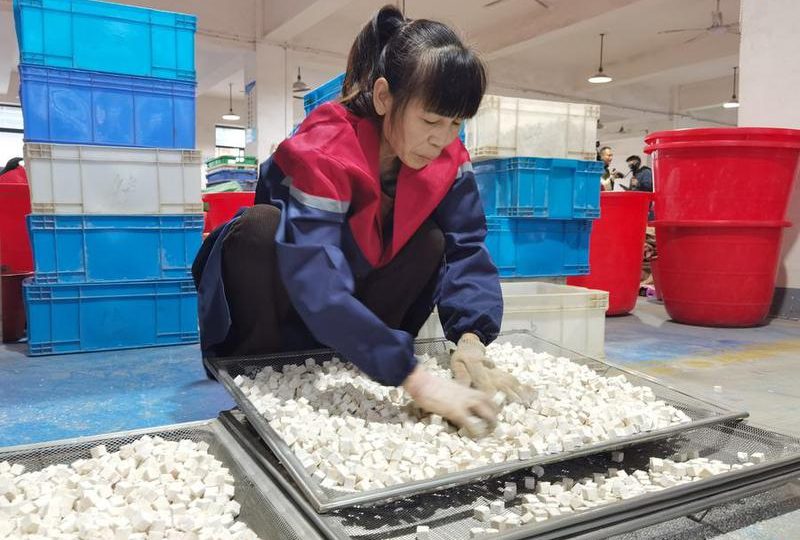
A staff member arranges cut pieces of poria cocos at a poria cocos processing factory in Jingzhou County, Huaihua, central China's Hunan Province, Oct. 22, 2025. (Xinhua/Wang Teng)
Chinese farmers seek economic gains in forest glades
CHANGSHA, Oct. 27 (Xinhua) — After resigning as a senior sales executive for a state-owned tobacco company in Shanghai, Yang Peiru registered a bamboo shoots processing company in his hometown, Huitong County, a hinterland in central China’s Hunan Province.
“The local government offered many preferential policies, which attracted me to bring investment back to my hometown,” said Yang, general manager of Hunan Green Land High-tech Agriculture and Forestry Development Co., Ltd. He added that government loans had bolstered the company’s capital and enhanced its production capacity.
“Due to the expansion and stability of production capacity, we have got many orders from big customers. Currently, our order volume has reached 200,000 packages per day,” Yang said.
Established in 2017, Yang’s company has contracted some 3,300 hectares of bamboo forest from local farmers to secure raw materials, with support from the local government.
“After the official launch of sales in June 2021, the performance has grown steadily, and it is expected to achieve sales of 80 million yuan (about 11.28 million U.S. dollars) by 2025,” Yang said.
Song Xiaofeng, a local villager who leased one hectare of bamboo forest to Yang’s company, now works on its production line, earning a monthly salary of 4,000 to 4,500 yuan.
“In the past, I could hardly make more than 1,000 yuan annually from my bamboo forest. Now, I earn about 50,000 yuan a year, including a 1,050 yuan land transfer fee,” said Song. She added that the job allows her to care for her elderly parents and children at home, rather than endure the hardships of working in the mountains every day.
About 40 kilometers from Yang’s company lies Jingzhou County, known for its waxberries and poria cocos, a common ingredient in traditional Chinese medicine.
Local people have found that growing poria cocos under waxberry trees effectively utilizes space, maintains vegetation balance, and prevents soil erosion.
“After harvesting, the poria cocos residue acts as organic fertilizer for the waxberry trees,” said Wang Xinzhi, general manager of Jingzhou Guoling Technology Co., Ltd., a local producer of poria cocos products. “We now use this model on 200 hectares of land.”
“Planting poria cocos under the waxberry trees is not only an innovation but also reduces costs and makes full use of land space and increases overall profits,” Wang said.
Near Wang’s company, there is a busy market for poria cocos. Many buyers and sellers come here every morning to trade poria cocos.
As one of the largest poria cocos industrial parks in China, Jingzhou County attracted 71 traditional Chinese medicine enterprises, over 300 processing households, 21 e-commerce enterprises, and four logistics enterprises by 2024, according to the local authorities.
The annual transaction volume reaches 80,000 tonnes, accounting for more than 70 percent of the national total.
Yang and Wang are the epitomes of China’s non-timber forest-based economy.
Included in the country’s 2025 government work report, the concept is an eco-friendly economic model that involves a compound operation involving forests and woodlands.
According to data from China’s National Forestry and Grassland Administration, by 2024, some 40 million hectares of forest land were utilized for this purpose, generating an annual output value of approximately 1 trillion yuan nationwide. ■








